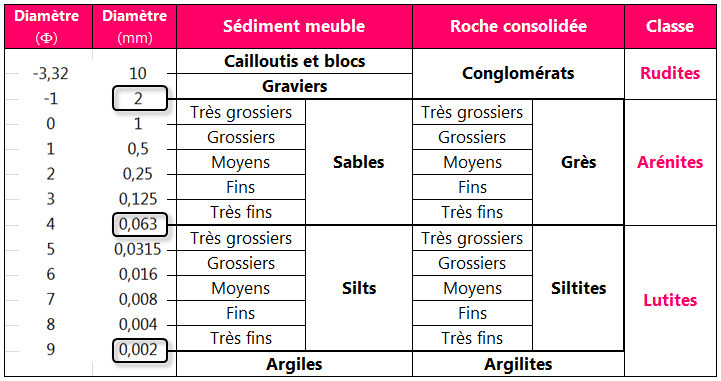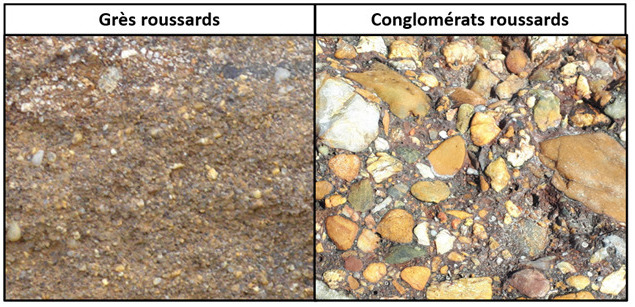
La Earthcache / The Earthcache
L'église de Saint Hilaire de Blaru présente pour sa construction différentes roches permettant d'en faire une étude comparée.
► Les "Roussards"
Les "Roussards" sont un ensemble de formation sédimentaire d'origine détritique. En que telle, leur nature lithologique dépend de la taille de ses sédiments (classification granulométrique).

Une roche "Roussard" se distinguent des autres formations détritiques par son ciment ferrugineux.
Sous un climat chaud et humide, les eaux enrichies en silice et fer cimentent les clastes en une cuirasse ferrugineuse, donnant une matrice de couleur brun profond à rouille, très dure.

► La Pierre Meulière
La pierre meulière est une roche sédimentaire siliceuse avec silicification irrégulière de calcaires.
D'un point de vue de la dureté, il n'est pas possible de la rayer avec une lame de métal. Cette résistance s'explique par sa richesse en silice.
Cette pierre meulière présente deux faciès :
~ Le faciès compact
La meulière compacte est massive, homogène, de couleur homogène gris-blanc et à texture très fine (douce au toucher).

~ Le faciès caverneux
Il s'agit d'une formation à aspect alvéolaire, spongieux.
Ces cavités sont issues de la dissolution du calcaire présent entre les zones silicifiées.
La couleur de ce faciès est très variable, due à des argiles bariolées dont les couleurs peuvent aller du blanc au rougeâtre en passant par le jaune.
Cette coloration va dépendre de la concentration en oxydes ferriques dans les argiles ; plus celle-ci est forte, plus la pierre prend une teinte rouge.

► Les silex
Les silex sont des accidents siliceux qui apparaissent dans des roches calcaires sous la forme de fines couches ou en rangées de nodules dispersés.
Le cœur du silex, ou cortex, est dur et possède une cassure courbe et esquilleuse (dite cassure conchoïdale), donne des éclats tranchants et résiste aux acides.
Le silex étant très riche en silice, cela donne une roche dure, impossible de rayer avec du métal.
La coloration des silex dépend en premier lieu du milieu oxydant ou réducteur ou s'est faite la silicification (plus le silex est sombre, plus le milieu est réducteur).

The church of Saint Hilaire de Blaru presents for its construction different rocks allowing to make a comparative study.
► The "Roussards"
The "Roussards" are a set of sedimentary formations of detrital origin. As such, their lithological nature depends on the size of its sediments (grain size classification).
A "Roussard" rock is distinguished from other detrital formations by its ferruginous cement.
In a hot, humid climate, waters enriched with silica and iron cement the clasts into a ferruginous armor, resulting in a very hard, deep brown to rust colored matrix.
► The Millstone
Millstone is a siliceous sedimentary rock with irregular silicification of limestones.
From a hardness point of view, it is not possible to scratch it with a metal blade. This resistance is explained by its richness in silica.
This millstone has two facies:
~ The compact facies
The compact millstone is massive, homogeneous, of homogeneous gray-white color and with a very fine texture (soft to the touch).
~ The cavernous facies
It is a formation with an alveolar, spongy appearance.
These cavities result from the dissolution of the limestone present between the silicified zones.
The color of this facies is very variable, due to variegated clays whose colors can range from white to reddish through yellow.
This coloration will depend on the concentration of ferric oxides in the clays; the stronger it is, the more the stone takes on a red tint.
► The flints
Flints are siliceous accidents which appear in limestone rocks in the form of thin layers or in rows of scattered nodules.
The heart of the flint, or cortex, is hard and has a curved and splintering break (known as conchoidal break), gives sharp splinters and is resistant to acids.
The flint being very rich in silica, it gives a hard rock, impossible to scratch with metal.
The coloring of the flints depends firstly on the oxidizing or reducing medium where the silicification took place (the darker the flint, the more reducing the medium).
► Sources bibliographiques / Bibliographical sources
Les Questions / The Questions
Questions pour valider :"Les Roches de Saint Hilaire de Blaru"
Questions to validate: "The Rocks of Saint Hilaire de Blaru"
- Question 0 : Prenez une photo de vous ou d'un élément vous appartenant devant l'église.
Cette photo devra au choix nous être transmise avec les réponses ou être ajoutée à votre log.
-Question 0 : Take a picture of yourself or something belonging to you in front of the church.
This photo must either be sent to us with the answers or added to your log.
Vous voici sur le côté droit de l'église Saint Hilaire. Repérer les 3 zones d'observation.
You are now on the right side of the Saint Hilaire church. Identify the 3 observation areas.

- Question 1 : Décrivez la roche de la zone rouge A pour identifier sa nature puis allez voir la question associée ci-dessous.
- Question 1: Describe the rock in red zone A to identify its nature, then see the associated question below.
- Question 2 : Décrivez la roche de la zone bleue B pour identifier sa nature puis allez voir la question associée ci-dessous.
- Question 2: Describe the rock in blue zone B to identify its nature then see the associated question below.
- Question 3 : Décrivez la roche de la zone verte C pour identifier sa nature puis allez voir la question associée ci-dessous.
- Question 3: Describe the rock in green zone C to identify its nature, then see the associated question below.
Questions complémentaires (justifiez à chaque fois votre réponse par vos observations) :
- Si la roche est un "Roussard" : en fonction de la taille des clastes, quelle est sa nature?
- Si la roche est un Silex : en fonction de sa couleur, son milieu de formation était il plutôt oxydant ou réducteur?
- Si la roche est une Pierre Meulière : de quel faciès s'agit-il ?
Additional questions (justify your answer each time with your observations):
- If the rock is a "Roussard": according to the size of the clasts, what is its nature?
- If the rock is a Flint: depending on its color, was its formation environment rather oxidizing or reducing?
- If the rock is a Meulière: what facies is it?
Vous pouvez vous loguer sans attendre notre confirmation,
mais vous devez nous envoyer les réponses en même temps soit par mail via notre profil (
fafahakkai), soit via la messagerie geocaching.com (Message Center).
S'il y a des problèmes avec vos réponses nous vous en ferons part.
Les logs enregistrés sans réponse seront supprimés.You can log this cache without waiting for our confirmation, but you must send us the answers at the same time, by e-mail via our profile (fafahakkai) or by the system of Message Center of geocaching.com.
If there is a problem with your answers we will notify you. The logs recorded without answers will be deleted.
Rappel concernant les « Earthcaches »: Il n'y a pas de conteneur à rechercher ni de logbook à renseigner. Il suffit de se rendre sur les lieux, de répondre aux questions ci-dessus et de nous renvoyer les réponses.
Reminder concerning "Earthcaches": there is neither a container to look for nor a logbook to sign. One need only go to the location, answer to the differents questions and send us the answers.